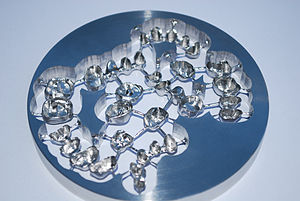Introduction to CAD/CAM Dentistry
- CAD/CAM is a process that converts non-digital data into a digital format.
- It is used to fabricate dental prostheses such as crowns, veneers, and orthodontic devices.
- Traditional prosthesis fabrication involves making an impression, creating a wax model, and casting the final product.
- CAD/CAM eliminates the need for physical techniques by recording impressions digitally and using additive or subtractive means for manufacturing.
- Examples of dental prostheses that can be manufactured using CAD/CAM include study models, cuspal coverage restorations, and removable denture frameworks.
- CAD/CAM dentistry was first used in the mid-1980s but was initially considered cumbersome and time-consuming.
- The commercialization of Cerec by Sirona made CAD/CAM more accessible to dentists.
- The first CAD/CAM system in dentistry was developed in the 1970s by Duret and colleagues.
- Various digitizers, such as laser beams and contact probes, were developed to improve CAD/CAM systems.
- CEREC and Procera are widely used CAD/CAM systems that have shown long-term clinical success.
CAD/CAM Process
- CAD/CAM systems consist of CAD and CAM stages.
- Optical or contact scanning captures the condition of the patient's teeth.
- Software turns the captured images into a digital model for designing the prosthesis.
- Devices such as 3D printers or milling machines are used to convert the design into a physical product.
- The process involves correcting decayed or broken areas of the tooth, taking an optical impression, and designing the prosthesis.
Materials and Techniques in CAD/CAM Dentistry
- CAD/CAM dentistry uses both subtractive processes (CNC milling) and additive processes (3D printing).
- Before the 2010s, CAD/CAM-directed manufacturing was primarily CNC cutting, but now both methods are widely used.
- CAD/CAM and milling technology are often treated as interchangeable terms, but CAD/CAM does not specify the method of production.
- CAD/CAM materials include metals, porcelain, lithium disilicate, zirconia, and resin.
- CAD/CAM restorations are milled from solid blocks.
- Pre-sintered ceramic ingots require subsequent sintering.
- Glass-based restorations can be manufactured using CAD-CAM.
- Metals like CoCr and titanium can be manufactured using CAD-CAM.
- Feldspathic and leucite-reinforced ceramics have good aesthetics but low flexural strength.
- Lithium disilicate, zirconium oxide, and lithium silicate ceramics have high flexural strength and good aesthetics.
- Zirconia has high flexural strength but weak optical properties and bonding ability.
- Resin materials include resin composite, PMMA, and Nano-ceramics with weak flexural strength.
Advantages and Disadvantages of CAD/CAM Dentistry
- Improved quality of prostheses in dentistry.
- Standardised production process.
- Increased productivity.
- Ability to work with new materials with high accuracy.
- Dentist's technique must be suited to CAD/CAM milling.
- Allows use of materials otherwise unavailable in the laboratory.
- Provides cheaper alternatives compared to conventional materials.
- Decreases labor cost and time for dental technicians.
- Standardizes the quality of restorations.
- Reduces labor times for ceramic dental prostheses.
- Rapid digitization of dental impressions.
- Eliminates risk of distortion/damage to data.
- Reduces discomfort for patients with strong gag reflex.
- Saves time in post-processing compared to conventional impressions.
- Enables instant emailing of 3D models to dental laboratories.
- Steep learning curve for operators.
- Requires a large financial investment.
- Errors in occlusion assessment compared to conventional techniques.
- Resin particles produced during milling contribute to plastic pollution.
- Difficulty achieving balanced occlusion without human assessment.
Future of CAD/CAM Dentistry
- Digital dentistry is growing at an accelerating rate.
- CAD/CAM systems will continue to evolve and improve.
- 20 new systems expected to become available by 2020.
- Further research needed to evaluate CAD/CAM technology compared to other attachment systems.
- Potential for advancements in materials and techniques in the future.
- The use of 3D printing in dentistry is becoming more prominent.
- Research is being conducted on the use of CAD/CAM technology for complete dentures.
- Integration with digital workflows and intraoral scanners is being explored.
- The future of CAD/CAM dentistry holds the potential for further advancements and innovations.
CAD/CAM dentistry is a field of dentistry and prosthodontics using CAD/CAM (computer-aided-design and computer-aided-manufacturing) to improve the design and creation of dental restorations, especially dental prostheses, including crowns, crown lays, veneers, inlays and onlays, fixed dental prostheses (bridges), dental implant supported restorations, dentures (removable or fixed), and orthodontic appliances. CAD/CAM technology allows the delivery of a well-fitting, aesthetic, and a durable prostheses for the patient. CAD/CAM complements earlier technologies used for these purposes by any combination of increasing the speed of design and creation; increasing the convenience or simplicity of the design, creation, and insertion processes; and making possible restorations and appliances that otherwise would have been infeasible. Other goals include reducing unit cost and making affordable restorations and appliances that otherwise would have been prohibitively expensive. However, to date, chairside CAD/CAM often involves extra time on the part of the dentist, and the fee is often at least two times higher than for conventional restorative treatments using lab services.

Like other CAD/CAM fields, CAD/CAM dentistry uses subtractive processes (such as CNC milling) and additive processes (such as 3D printing) to produce physical instances from 3D models.
Some mentions of "CAD/CAM" and "milling technology" in dental technology have loosely treated those two terms as if they were interchangeable, largely because before the 2010s, most CAD/CAM-directed manufacturing was CNC cutting, not additive manufacturing, so CAD/CAM and CNC were usually coinstantiated; but whereas this loose/imprecise usage was once somewhat close to accurate, it no longer is, as the term "CAD/CAM" does not specify the method of production except that whatever method is used takes input from CAD/CAM, and today additive and subtractive methods are both widely used.